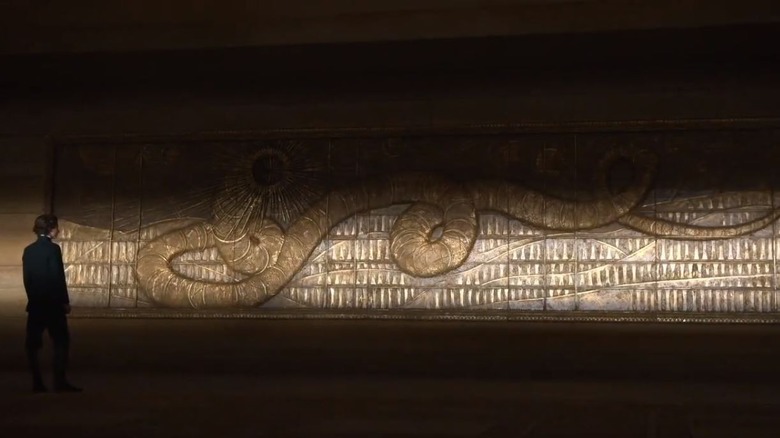Dune Production Designer Breaks Down The Sand Worm Mural & Fremen Writing [Exclusive]
One of the biggest advantages (or drawbacks, depending on your perspective) when it comes to adapting "Dune" is the overwhelming amount of world-building, lore, and mythology that author Frank Herbert created for his original novel. The Denis Villeneuve movie, by necessity, simply couldn't include each and every one of those rich details while still clocking in at a reasonable runtime. But that doesn't mean the film is completely bereft of its influences — the creative team simply had to find other clever ways to integrate such aspects into the world of the story beyond having characters explain these things through dialogue. There's probably no one better to question about these details than Patrice Vermette, the production designer of "Dune," who spoke at length with /Film about the approach to making the world of Arrakis feel lived-in and believable.
'Writing on the Wall'
How do you get information across to audiences as efficiently as possible in blockbuster epics? Peter Jackson's "The Lord of the Rings" frontloaded the opening of the first film with a flashback info-dump that explains much of the backstory preceding the events of "The Fellowship of the Ring." George Lucas' "Star Wars" mostly opts for bare-bones approach, throwing audiences headfirst into scenes like the famous Mos Eisley cantina sequence.
With "Dune," Villeneuve and his team put immense effort into designing the locations and setting of each world in "Dune." When talking to production designer Patrice Vermette recently, /Film's Jack Giroux asked about the reasoning behind the Fremen writing included in scenes set in the Imperial lab.
"It was to make this planet a more livable place. It was before they discovered the spice, so I was imagining that the emperor would've probably hired local labor to help build those cells. Just like in Egypt, they would've written their story on the walls. There's the color of the sandstone, but it's also words written in Fremen language. With the writing on the wall, I had a bit of fun."
Elsewhere on Arrakis, Paul Atreides (Timothée Chalamet) gazes at the striking artwork of a sandworm during an early scene. When asked about any specific set details that viewers may have easily overlooked, Vermette points toward that relatively brief moment in the film.
"We spent a lot of time looking at the mural of the worm. The mural of the worm is part of multiple murals and those were made to tell the story of the spice exploitation through the eyes of the local culture and the worm. The first time we encounter a representation of the worm, it's through that mural. The worm is designed to look ominous and more like a deity, like a godlike creature with the sun coming from its mouth. And around it, you see that there's small, small characters just to show the scale of the worm. There's a harvester there in that mural, too. It's a bit like the writing on the wall for the laboratory. It's how the Fremen are trying to tell their story, to talk about their existence, in this colonial palace. Their voice is there."
With "Dune" still streaming on HBO Max, viewers can remain on the look-out for all sorts of insightful details like these.

